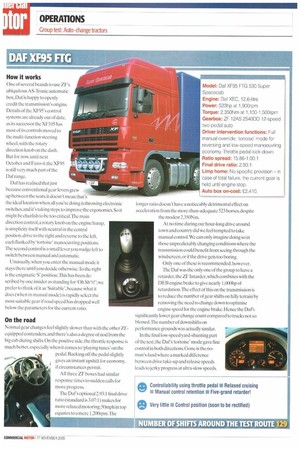How it works
Page 46

If you've noticed an error in this article please click here to report it so we can fix it.
One of several brands to use ZF's ubiquitous A S-Tronic automatic box, Daf is happy to openly credit the transmission's origins. Details of the XF95's control systems are already out of date, as its successor the XF105 has most of its controls moved to the multi-function steering wheel, with the rotary direction knob on the dash. But for now, until next October and Euro-4, the XF95 is still very much part of the Daf range.
Daf has realised that just because conventional gear levers grew up between the seats. it doesn't mean that's the ideal location when all you're doing is throwing electronic switches, and it's taking steps to improve the ergonomics. So it might be churlish to be too critical.The main direction control, a rotary knob on the engine hump, is simplicity itself with neutral in the central position, drive to the right and reverse to the left, each flanked by 'tortoise' inanoeuvring positions. The second control is a small lever you nudge left to switch between manual and automatic.
Unusually when you enter the manual mode it stays there until you decide otherwise.To the right is the enigmatic 'S' position.This has been described by one insider as standing for 'Oh SV': we prefer to think of it as 'Suitable', because what it does (when in manual mode) is rapidly select the most suitable gear if road speed has dropped well below the parameters for the current ratio.
On the road
Normal gear changes feel slightly slower than with the other ZFequipped contenders, and there's also a degree of nod from the big cab during shifts. On the positive side, the throttle response is much better, especially when it comes to`playing tunes' on the pedal. Backing off the pedal slightly gives an instant upshift for economy, if circumstances permit.
All three ZF boxes had similar response times to sudden calls for more progress.
The Dafs optional 2.93:1 final drive ratio (standard is 3.07:1) makes for more relaxed motoring:50mph in top equates to a mere 1.200rpm.The longer ratio doesn't have a noticeably detrimental effect on acceleration from the more-than-adequate 523 horses, despite the modest 2,350Nm.
At no time during our hour-long drive around town and country did we feel tempted to take manual control.We can only imagine doing so in those unpredictably changing conditions where the transmission could benefit from seeing through the windscreen, or if the drive gets too boring.
Only one of these is recommended. however.
The Daf was the only one of the group to have a retarder, the ZF lntarder, which combines with the DEB engine brake to give nearly 1,000hp of retardation.The effect of this on the transmission is to reduce the number of gear shifts on hilly terrain by removing the need to change down to optimise engine speed for the engine brake. Hence the Dafs significantly lower gear-change count compared to trucks not so blessed.The number of downshifts on performance grounds was actually similar.
in the final low-speed yard-shunting part of the test, the Dafs 'tortoise' mode gave fine control in both directions. Gone is the noman's-land where a marked difference between drive take-up and release speeds leads to jerky progress at ultra-slow speeds.






































































































































































































